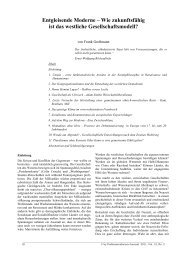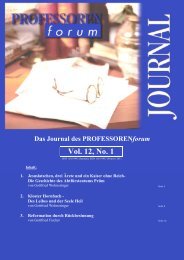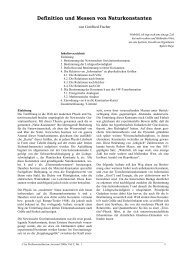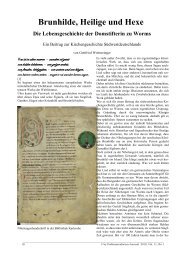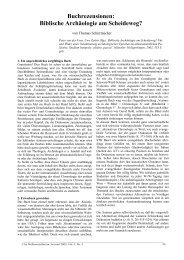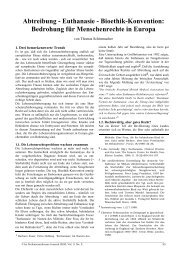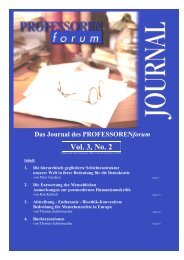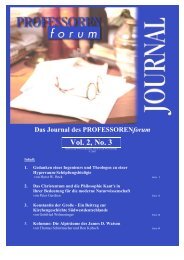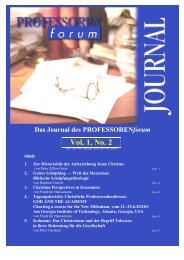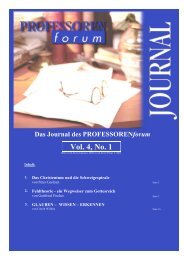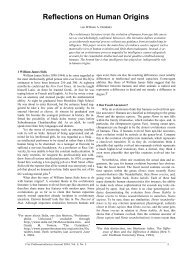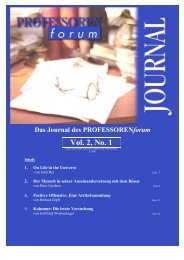Vol. 1, No. 1 Vol. 4, No. 2 - Professorenforum
Vol. 1, No. 1 Vol. 4, No. 2 - Professorenforum
Vol. 1, No. 1 Vol. 4, No. 2 - Professorenforum
Erfolgreiche ePaper selbst erstellen
Machen Sie aus Ihren PDF Publikationen ein blätterbares Flipbook mit unserer einzigartigen Google optimierten e-Paper Software.
The problem of false negatives therefore arises either when<br />
an intelligent agent has acted (whether consciously or unconsciously)<br />
to conceal one’s actions, or when an intelligent<br />
agent, in trying to detect design, has insufficient background<br />
knowledge to determine whether design actually is present.<br />
This is why false negatives do not invalidate the complexity-specification<br />
criterion. This criterion is fully capable of<br />
detecting intelligent causes intent on making their presence<br />
evident. Masters of stealth intent on concealing their actions<br />
may successfully evade the criterion. But masters of selfpromotion<br />
bank on the complexityspecification criterion to<br />
make sure their intellectual property gets properly attributed.<br />
Indeed, intellectual property law would be impossible<br />
without this criterion. And that brings us to the problem of<br />
false positives. Even though specified complexity is not a<br />
reliable criterion for eliminating design, it is a reliable criterion<br />
for detecting design. The complexity-specification<br />
criterion is a net. Things that are designed will occasionally<br />
slip past the net. We would prefer that the net catch more<br />
than it does, omitting nothing due to design. But given the<br />
ability of design to mimic unintelligent causes and the possibility<br />
of ignorance causing us to pass over things that are<br />
designed, this problem cannot be remedied. Nevertheless,<br />
we want to be very sure that whatever the net does catch<br />
includes only what we intend it to catch— namely, things<br />
that are designed. Only things that are designed had better<br />
end up in the net. If that is the case, we can have confidence<br />
that whatever the complexity-specification criterion attributes<br />
to design is indeed designed. On the other hand, if<br />
things end up in the net that are not designed, the criterion is<br />
in trouble.<br />
How can we see that specified complexity is a reliable criterion<br />
for detecting design? Alternatively, how can we see<br />
that the complexityspecification criterion successfully<br />
avoids false positives— that whenever it attributes design, it<br />
does so correctly? The justification for this claim is a<br />
straightforward inductive generalization: In every instance<br />
where specified complexity obtains and where the underlying<br />
causal story is known (i.e., where we are not just dealing<br />
with circumstantial evidence, but where, as it were, the<br />
video camera is running and any putative designer would be<br />
caught red-handed), it turns out design actually is present;<br />
therefore, design actually is present whenever the complexityspecification<br />
criterion attributes design.<br />
Although this justification for the complexity-specification<br />
criterion’s reliability at detecting design may seem a bit too<br />
easy, it really isn’t. If something genuinely instantiates<br />
specified complexity, then it is inexplicable in terms of all<br />
material mechanism (not only those that are known but all<br />
of them). Indeed, to attribute specified complexity to something<br />
is to say that the specification to which it conforms<br />
corresponds to an event that is highly improbable with respect<br />
to all material mechanism that might give rise to the<br />
event. So take your pick— treat the item in question as inexplicable<br />
in terms of all material mechanisms or treat it as<br />
designed. But since design is uniformly associated with<br />
specified complexity when the underlying causal story is<br />
known, induction counsels attributing design in cases where<br />
the underlying causal story is not known.<br />
To sum up, for specified complexity to eliminate chance<br />
and detect design, it is not enough that the probability be<br />
small with respect to some arbitrarily chosen probability<br />
distribution. Rather, it must be small with respect to every<br />
probability distribution that might characterize the chance<br />
occurrence of the thing in question. If that is the case, then a<br />
design inference follows. The use of chance here is very<br />
broad and includes anything that can be captured mathematically<br />
by a stochastic process. It thus includes deterministic<br />
processes whose probabilities all collapse to zero and<br />
one (cf. necessities, regularities, and natural laws). It also<br />
includes nondeterministic processes, like evolutionary processes<br />
that combine random variation and natural selection.<br />
Indeed, chance so construed characterizes all material<br />
mechanisms.<br />
5. Assertibility<br />
The reliability of specified complexity as a criterion for<br />
detecting design is not a problem. Neither is there a problem<br />
with specified complexity’s coherence as a meaningful<br />
concept— specified complexity is well-defined. If there’s a<br />
problem, it centers on specified complexity’s assertibility.<br />
Assertibility is a term of philosophical use that refers to the<br />
epistemic justification or warrant for a claim. Assertibility<br />
(with an “i”) is distinguished from assertability (with an<br />
“a”), where the latter refers to the local factors that in the<br />
pragmatics of discourse determine whether asserting a claim<br />
is justified (see Jackson 1987, 11). For instance, as a tourist<br />
in Iraq I might be epistemically justified asserting that Saddam<br />
Hussein is a monster (in which case the claim would be<br />
assertible). Localpragmatic considerations, however, tell<br />
against asserting this remark within Iraqi borders (the claim<br />
there would be unassertable). Unlike assertibility, assertability<br />
can depend on anything from etiquette and good<br />
manners to who happens to hold political power. Assertibility<br />
with an “i” is what interests us here.<br />
To see what’s at stake with specified complexity’s assertibility,<br />
consider first a mathematical example. It’s an open<br />
question in mathematics whether the number pi (the ratio of<br />
the circumference of a circle to its diameter) is regular,<br />
where by regular I mean that every number between 0 and 9<br />
appears in the decimal expansion of pi with limiting relative<br />
frequency 1/10. Regularity is a well-defined mathematical<br />
concept. Thus, in asserting that pi is regular, we might be<br />
making a true statement. But without a mathematical proof<br />
of pi’s regularity, we have no justification for asserting that<br />
pi is regular. The regularity of pi is, at least for now, unassertible<br />
(despite over 200 billion decimal digits of pi having<br />
been computed). But what about the specified complexity of<br />
various biological systems? Are there any biological systems<br />
whose specified complexity is assertible? Critics of<br />
intelligent design argue that no attribution of specified<br />
complexity to any natural system can ever be assertible. The<br />
argument runs as follows. It starts by noting that if some<br />
natural system instantiates specified complexity, then that<br />
system must be vastly improbable with respect to all purely<br />
natural mechanisms that could be operating to produce it.<br />
But that means calculating a probability for each such<br />
mechanism. This, so the argument runs, is an impossible<br />
task. At best science could show that a given natural system<br />
is vastly improbable with respect to known mechanisms<br />
operating in known ways and for which the probability can<br />
_________________________________________________________________________________________________________________<br />
© by <strong>Professorenforum</strong>-Journal 2003, <strong>Vol</strong>. 4, <strong>No</strong>. 2 15



